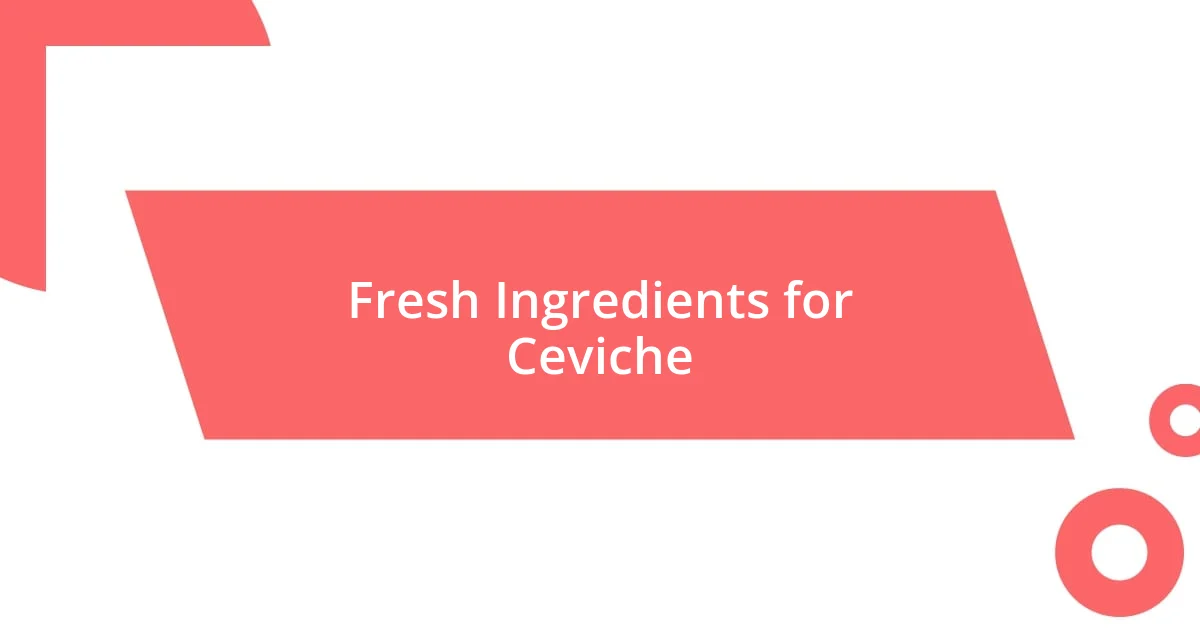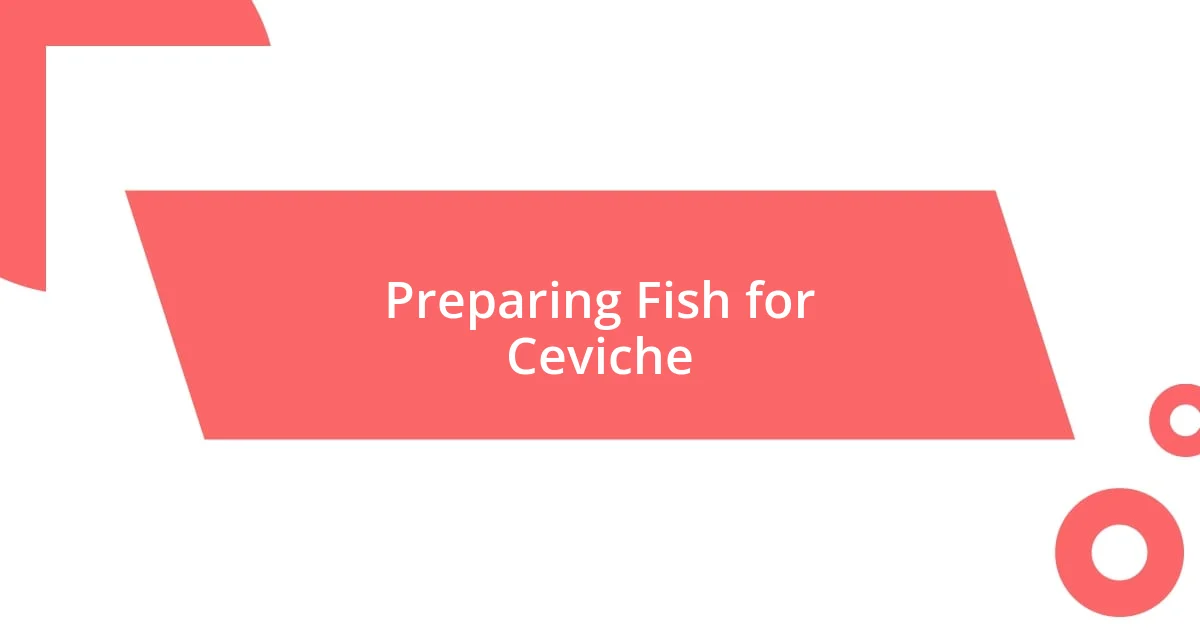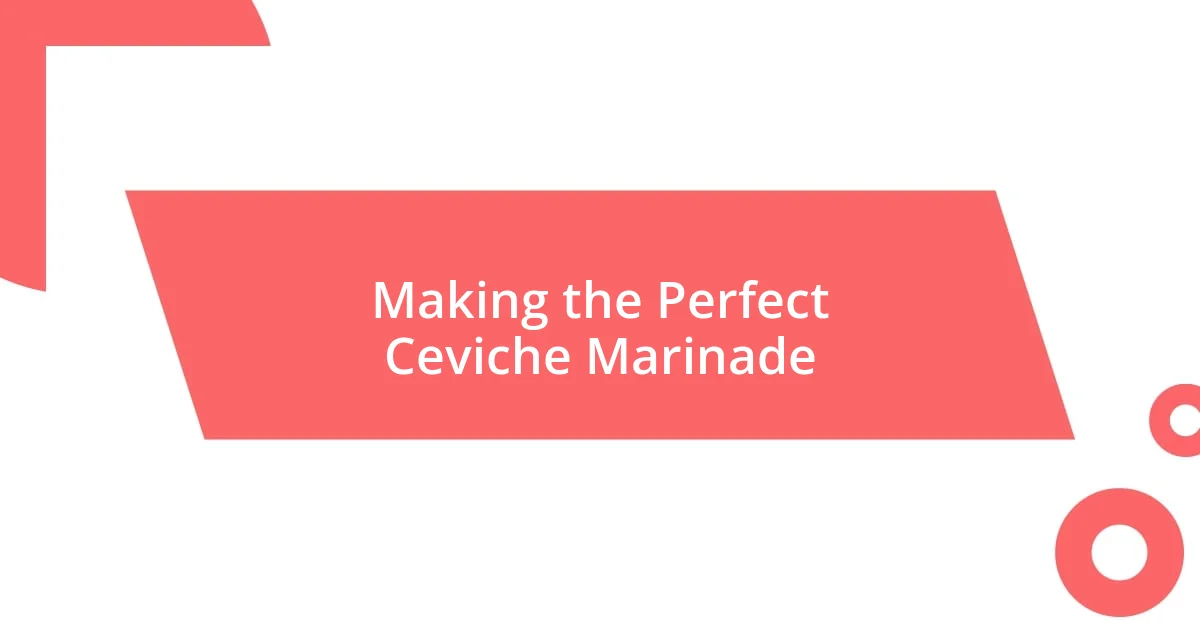Key takeaways:
- Understanding different types of ceviche, such as Peruvian, Ecuadorian, and Mexican, enhances appreciation and highlights cultural significance.
- Fresh ingredients are crucial; seafood quality, vibrant vegetables, and citrus juice are essential for flavor and texture.
- Proper preparation techniques, including marination time and creative garnishing, can elevate the dining experience and lead to memorable meals.

Understanding Ceviche Types
When it comes to ceviche, understanding the various types can truly enhance your appreciation for this dish. Take Peruvian ceviche, for example—often made with fresh white fish and marinated in lime juice, it’s a vibrant mix of flavors that captures the essence of the ocean. I remember the first time I tried it; the zesty acidity hit my taste buds just right, making me think, “Is there a better way to enjoy seafood?”
Then there’s Ecuadorian ceviche, which typically incorporates tomato sauce, giving it a distinct twist. The sweetness of the tomatoes adds a layer of richness that sets it apart. I’ve often hosted friends for a ceviche night, and watching their surprise at this version reminded me just how diverse and exciting ceviche can be. Have you ever tried different styles side by side? The contrast can be quite enlightening.
Another variation is Mexican ceviche, where you might find ingredients like avocado and jalapeño mixed in. The creaminess of the avocado combined with a spicy kick creates a wonderful contrast. Each type tells a story, don’t you think? By exploring these regional differences, I’ve discovered not just the delicious nuances but also the cultural significance that these dishes carry.

Fresh Ingredients for Ceviche
When preparing ceviche, the freshness of your ingredients is paramount. I can’t stress enough the importance of using high-quality seafood when making this dish. I recall a time at a local fish market when I picked up some freshly caught snapper. The moment I sliced into it, the scent of the ocean filled the air, and I knew it would make an incredible ceviche.
Alongside fresh seafood, don’t overlook the role of vegetables in balancing flavors. Whenever I create my ceviche, I include vibrant ingredients like red onion, cilantro, and tomatoes. The crunch of the vegetables and their bright colors not only make the dish visually appealing but also enhance the overall flavor profile. Have you ever noticed how a pop of color can elevate the dining experience? It’s fascinating how the right combination of fresh veggies can turn a simple meal into a culinary masterpiece.
Lastly, the citrus element is critical. I prefer using fresh lime juice, as its tartness brightens the dish and helps “cook” the fish. On a memorable summer day, I prepared ceviche for a gathering, and the zesty aroma of lime filled the kitchen. The first bite was pure bliss—refreshing and refreshing! It’s that sharp tang paired with fresh ingredients that makes each taste unforgettable.
| Ingredient | Importance |
|---|---|
| Seafood | Freshness ensures flavor and safety |
| Vegetables | Add texture and color |
| Citrus Juice | Brightens the dish and “cooks” the seafood |

Preparing Fish for Ceviche
When preparing fish for ceviche, choosing the right type is essential. My go-to fish is often a firm white fish like halibut or snapper, which holds up well in the acidic marinade. It’s a little like selecting the perfect canvas for a painting; the better the quality of the fish, the more vibrant your final dish will be. I remember making ceviche with freshly caught mahi-mahi—its texture was so impressive. I could hardly wait to dive into that tangy, delicious dish!
Here’s a breakdown of key considerations for preparing fish for ceviche:
- Freshness: Always opt for seafood that’s been caught fresh. If you can, visit local markets or trusted fishmongers. The aroma and visual appeal should scream freshness.
- Type of Fish: Though many varieties can work, select fish that are firm and have minimal fishy odor. Besides snapper, I’ve had success with sea bass, which adds a lovely flavor.
- Cutting Technique: Cut the fish into uniform cubes. This ensures an even “cooking” process in the acidic marinade. I’ve learned that the size of the dice can significantly impact the dish’s texture.
- Marination Time: Don’t over-marinate! A couple of hours is generally ideal, but I’ve found that 30 minutes can be perfect for delicate fish. It’s all about achieving that ideal balance of flavor without losing the fish’s natural essence.

Making the Perfect Ceviche Marinade
When it comes to creating the perfect ceviche marinade, I focus on balancing acidity and flavor. I like to combine fresh lime juice with a splash of orange juice for a hint of sweetness that rounds out the tartness. Thinking back on my ceviche experiments, I remember the first time I added zest from the lime; it elevated the flavor to a whole new level. Have you ever tried a marinade and just felt like it “clicked”? That’s what I strive for with every batch.
I also make it a point to include herbs and spices in my marinade. Fresh cilantro is a must—it brings a fresh, earthy taste that complements the seafood beautifully. On a recent Sunday gathering, I decided to incorporate a pinch of chili flakes for a slight kick. The response was amazing; my friends loved that little surprise! It’s interesting how a simple change in seasoning can transform the experience, isn’t it?
Another essential aspect is allowing the marinade to blend. After mixing it all together, I let it sit for about 15 minutes before adding the fish. This allows the flavors to develop and create that aromatic depth that will tantalize the senses. I still remember the first time I tasted ceviche someone had marinated correctly; it was vibrant, with layers of flavor that danced on my palate. That’s what I aim for every time I prepare my ceviche!

Serving and Garnishing Ceviche
One of my favorite ways to serve ceviche is in a chilled, elegant glass—think martini or cocktail glasses. It not only adds a touch of sophistication but also allows guests to appreciate the vibrant colors of the ceviche. I remember presenting my dish at a family gathering, and seeing the delight on everyone’s faces as they admired the layers of bright fish, herbs, and citrus. It’s amazing how the visual presentation heightens anticipation, isn’t it?
For garnishing, I always opt for the classics: slices of avocado and fresh cilantro leaves. The creaminess of the avocado perfectly balances the acidity of the ceviche, while cilantro adds a burst of freshness. Recently, I experimented with edible flowers as an additional garnish. The flowers not only look stunning but also offered a subtle flavor boost, transforming a simple dish into something extraordinary. Have you thought about making your ceviche a feast for the eyes as well as the palate?
When serving ceviche, I also like to accompany it with tortilla chips or crispy plantain chips. The crunch adds a delightful texture contrast to the tender seafood. I recall a lazy Sunday afternoon when I made a big bowl of ceviche and served it with a variety of dips. The combination created a fun, interactive dining experience. It’s those little touches that make serving ceviche memorable, encouraging everyone to dig in and share their thoughts on the flavors.

Ceviche Variations to Try
Thinking about ceviche variations truly gets me excited! I’ve experimented with different types of fish and seafood, and I find that swapping the classic white fish for shrimp or octopus can create a delightful twist. Just last summer, I prepared a shrimp ceviche with mango, and the sweetness of the fruit paired with the tangy lime juice was utterly refreshing. Have you tried combining fruits with your ceviche? I still remember how my friends were surprised by that unexpected flavor combination—and the smiles on their faces said it all.
Another unique variation I love is the incorporation of tropical fruits such as pineapple or papaya. The citrusy zing from the lime mingles beautifully with the sweetness of the fruit, creating a balance that keeps your taste buds guessing. One evening, I hosted a small gathering and decided to try a papaya ceviche. Guests were curious at first, but once they took a bite, the praises flowed. Isn’t it incredible how a simple addition like this can change the entire experience of a dish?
Spicing things up is also a fun way to play with ceviche. A jalapeño-infused marinade can add a kick that some of my friends absolutely adore. I still chuckle when I think back to a dinner party where I went a bit overboard with the heat, leaving my friends in stitches while reaching for the water! The laughter mixed with the flavors created a memorable night. Have you dared to try varying the spiciness in your ceviche? It’s moments like these that elevate the dish from just a meal to an unforgettable experience.

Tips for Ceviche Storage
When it comes to storing ceviche, timing is everything. I always aim to consume it within a day for the best flavor and texture. The longer it sits, the more the acidity from the citrus “cooks” the fish, which can lead to a mushy texture. Have you ever been wary of leftovers because of that? I remember the first time I found a two-day-old ceviche in my fridge and hesitated. Trust me; freshness is key!
If you do need to store ceviche for a few hours, I’ve found that keeping it in an airtight container in the fridge works wonders. Covering it helps maintain that fresh taste while preventing it from absorbing other odors. I once made the mistake of leaving it uncovered—let’s just say, my lovely seafood dish ended up tasting like last night’s takeout. Such a bummer, right?
Lastly, I recommend keeping the garnish separate until you’re ready to serve. This simple step helps maintain the avocado’s creaminess and the cilantro’s fresh flavor, ensuring that your ceviche remains vibrant. During a lively picnic, I discovered how mixing garnishes right away dulled the dish’s appeal. It was a great lesson in the importance of presentation! So, have you thought about how an extra step can elevate your ceviche experience?















